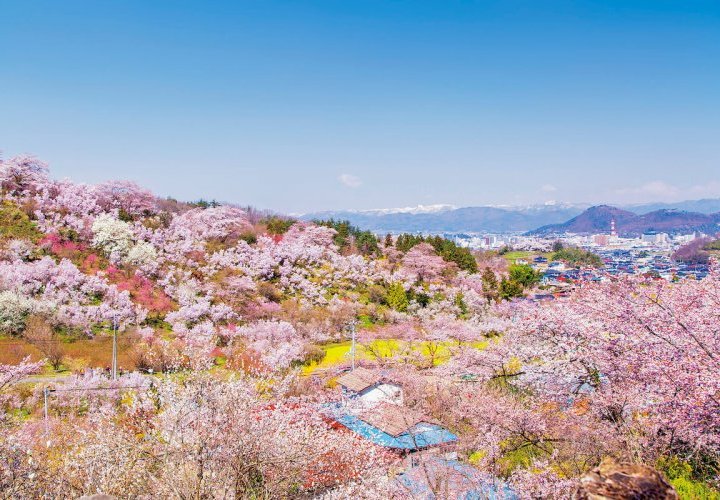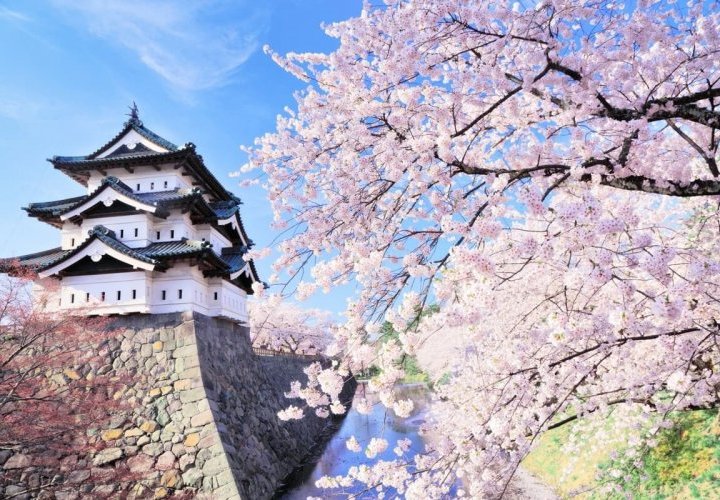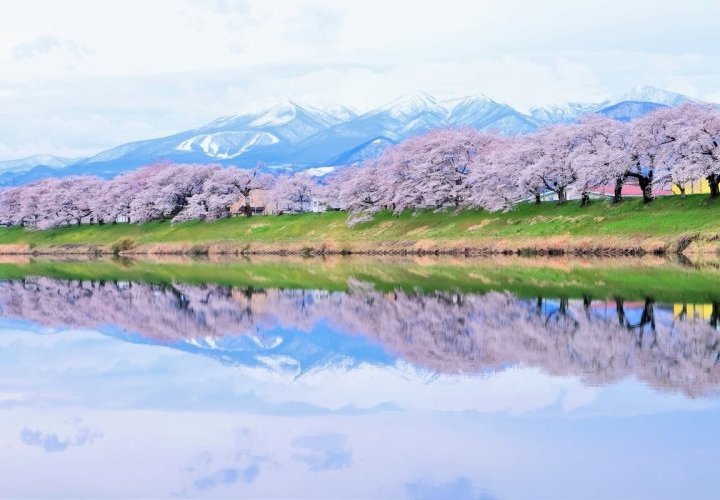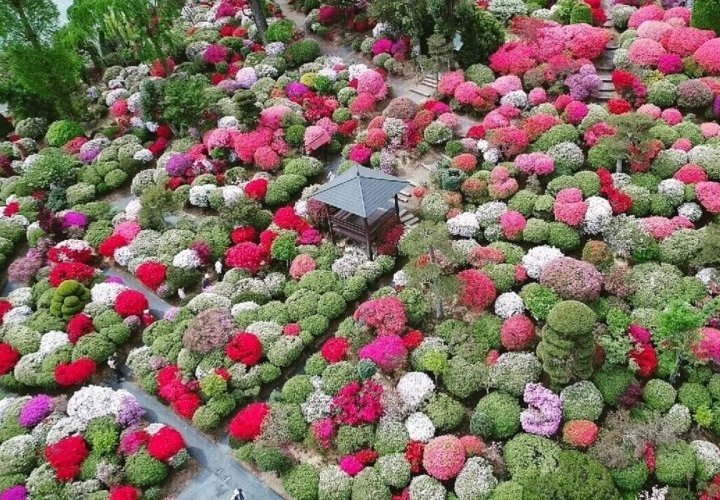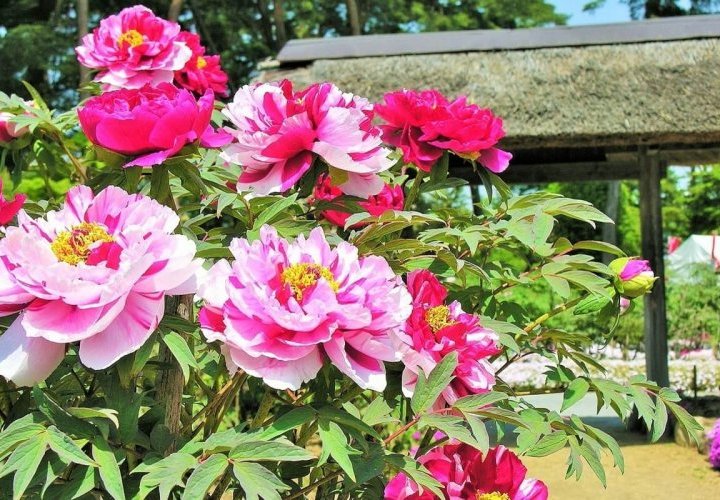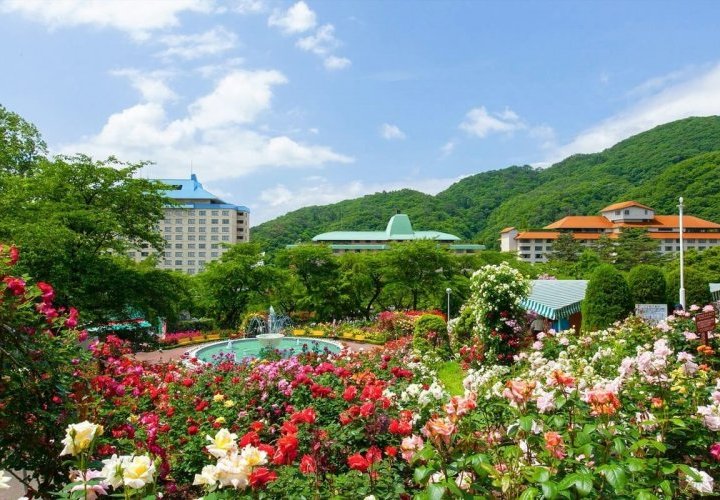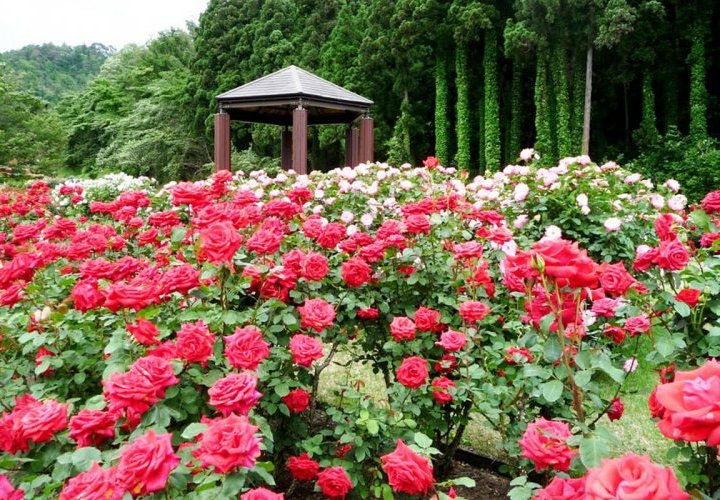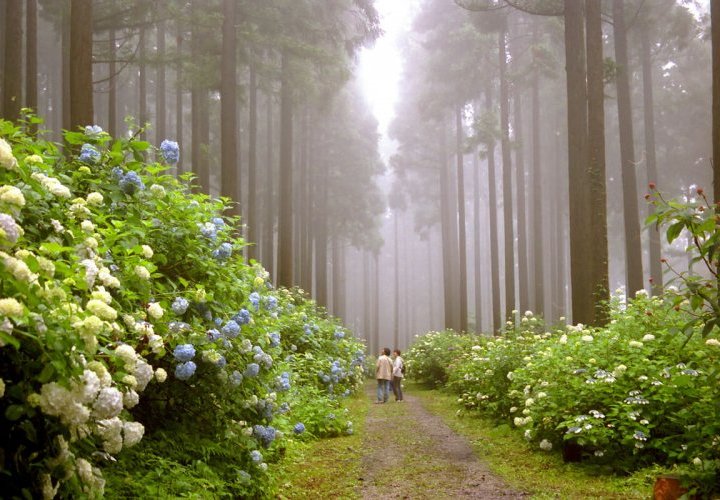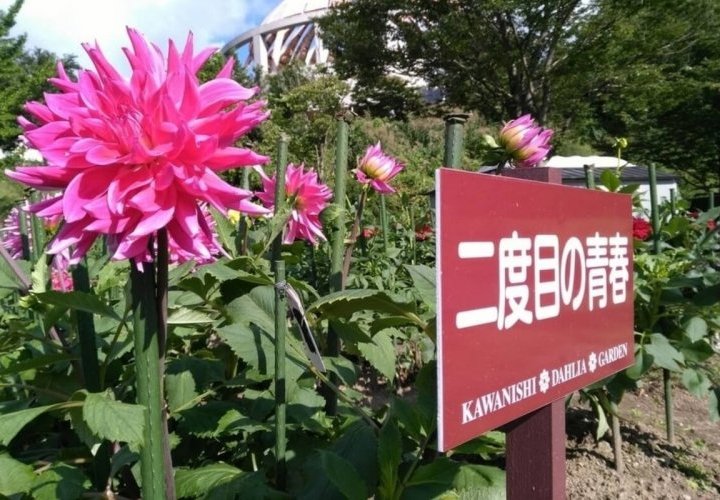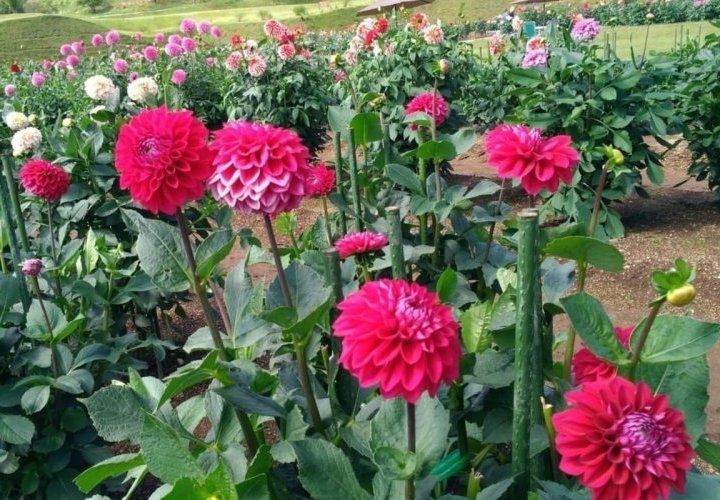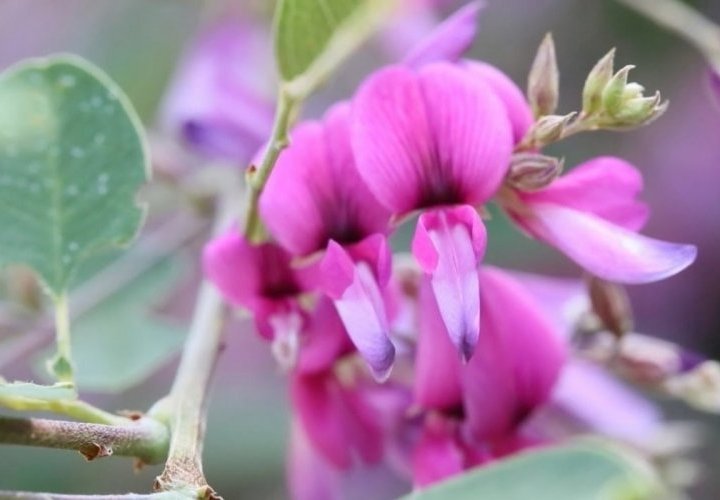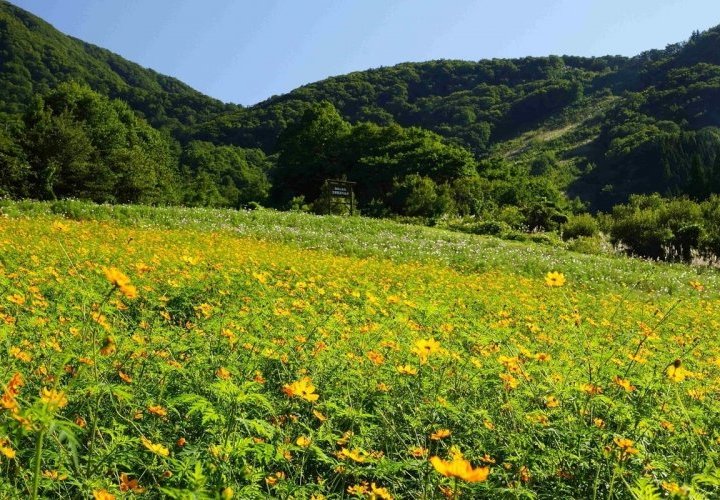Plum blossoms in Hanamiyama Park, Fukushima (late February to mid-March)
Hanamiyama Park, located outside of Fukushima city, is one of the best places to enjoy flower viewing in Japan, especially plum and cherry blossoms. It is a privately owned park open to public for free during the blooming season. Around 300 plum trees bloom in the park from late February to mid-March, delivering the announcement of arrival of spring. The picturesque view of the flower-filled mountain is often described as a Shangri-La (fictional place described in the novel Lost Horizon by the British author James Hilton) in real life.
Cherry blossoms in Funaoka Joshi Park, Shibata (early to mid-April)
Funaoka Joshi Park is the only one in Miyagi Prefecture selected as one of Japan’s top 100 cherry blossom-viewing spots. more
Hanamiyama Park, located outside of Fukushima city, is one of the best places to enjoy flower viewing in Japan, especially plum and cherry blossoms. It is a privately owned park open to public for free during the blooming season. Around 300 plum trees bloom in the park from late February to mid-March, delivering the announcement of arrival of spring. The picturesque view of the flower-filled mountain is often described as a Shangri-La (fictional place described in the novel Lost Horizon by the British author James Hilton) in real life.
Cherry blossoms in Funaoka Joshi Park, Shibata (early to mid-April)
Funaoka Joshi Park is the only one in Miyagi Prefecture selected as one of Japan’s top 100 cherry blossom-viewing spots. more
There are around 1,300 yoshino cherry trees in the park and in order to enjoy the beautiful scenery, you are recommended to take a monorail slope car through the 305-metre long sakura tunnel and arrive at the 24-metre tall Funaoka Heiwa Kannon statue on the mountaintop. The park is connected with the Shiraishi River and you can also view the cherry blossoms by the Shibata Sen’oukyo Bridge.
Cherry blossoms in Hanamiyama Park, Fukushima (early to late April)
Hanamiyama Park is a privately owned park known as one of the most beautiful cherry blossom spots in whole Japan. The park with a vast area of 5 ha is opened to the public for free during the blooming season offering the possibility to enjoy a wide range of flowers in bloom including plum, cherry, peach, etc. The pink cherry blossom-filled mountain, the snow covered Azuma Mountain Range in distance and the blue sky make the perfect combination.
Cherry blossoms in Tsutsujigaoka Park, Sendai (early April to early May)
Located to the east of Sendai Station, Tsutsujigaoka Park boasts around 1,000 different cherry blossom trees of such varieties as Yoshino cherry, weeping cherry, Yaezakura and Ukon cherry trees. You will be able to see the unique Ukon cherry variety, whose flowers have a light yellow shade. Besides cherry blossoms viewing, you can have a picnic, enjoy performances and taste local snacks in the park.
Cherry blossoms at Hirosaki Castle, Hirosaki (mid to late April)
As one of Japan’s top 100 cherry blossom-viewing spots, Hirosaki Park attracts about 2 million people during sakura season. There are over 2,600 cherry trees planted within the park site and due to excellent pruning techniques, the life span of Yoshino cherry trees here has increased to over 100 years, which normally is 60 to 80 years. The majestic Hirosaki castle and pink cherry blossoms create a spectacular scenery that can be enjoyed not only during the blooming season, but also after petals falling. At the end of full bloom, you can rent a rowing boat in order to admire the sakura carpet on the moats. The best viewing time for fallen petals is usually late April to early May.
Cherry blossoms along the Shiroishi River, Ogawara (mid to late April)
The Shiroishi River is a famous cherry blossom viewing spot in Ogawara town, Miyagi Prefecture that offers the dynamic view of “Thousand of Cherry Blossoms at Once Glance”. Around 1,200 cherry trees grow along the Shiroishi River for about 8 km and create a spectacular view in combination with Mount Zao in the distance. The place attracts many visitors including professional photographers every year during the cherry blossom season and the cherry blossom festival “Ogawara Sakura Matsuri”. During the festival period, a cherry blossom viewing riverboat that runs for 2 km down the Shiroishi River is also available.
Cherry blossoms in Mikamine Park, Sendai (mid to late April)
Mikamine Park is a spacious public park located in the south of central Sendai, planted with around 750 trees of various types, including Yoshino cherry, Weeping cherry and Yaezakura. It features the greatest number of cherry blossom trees in downtown Sendai, allowing viewers to enjoy hanami and hold cherry blossom viewing parties underneath its cherry trees.
Cherry blossoms in Tsuruoka Park, Tsuruoka (mid to late April)
Tsuruoka Park is one of Japan’s top 100 cherry blossom viewing spots gifted with around 730 sakura trees of various kinds such as Yoshino cherry, Double-Flowering cherry, and Weeping cherry. It is the ideal place to enjoy sakura in Tsuruoka, Yamagata Prefecture. The original castle was renovated into a park in 1875 and currently offers some historic sites, such as walls, moats and 100-year-old trees.
Miharu Takizakura blossom, Miharu (mid to late April)
The 1000-year-old Miharu Takizakura is one of the oldest cherry trees in Japan. The weeping higan cherry tree (Prunus pendula “Pendula Rosea”), which is 13.5 metres high and has a trunk circumference of 9.5 metres, was designated a national treasure in 1922. It was classified as one of the three giant cherry trees of Japan and attracts around 300,000 viewers every spring with its pink flowers in full blossom that spread in all directions from the branches, like a waterfall.
Cherry blossoms in Kitakami Tenshochi Park, Kitakami (mid-April to early May)
Kitakami Tenshochi is a scenic park located by the Kitakami River in Kitakami city, Iwate Prefecture and one of the most famous cherry blossom viewing spots in Tohoku area along with Hirosaki Castle. It is one of Japan’s top 100 sakura viewing spots and one of the three best places to enjoy sakura in Michinoku. There are over 10,000 cherry trees of around 150 varieties in the 3 ha park, the best highlight of the park being the 2 km long avenue lined by over 500 cherry trees which form an astonishing sakura tunnel. During the cherry blossom festival, various events and activities are held in the park including horse wagon wiring under cherry trees, sightseeing river cruise, night light-up of the cherry trees and many more.
Cherry blossoms at the foot of Mount Iwaki, Hirosaki (late April to early May)
The 20 km long road at the southern foot of Mt. Iwaki is the world’s longest sakura road lined with 6,500 cherry blossom trees that were planted over a 10-year period starting in 1985. The landscape is decorated with pale pink flowers, light green trees and white snow mountain ranges every early May. The walking path from Komoriyama-iriguchi bus stop to Dake Hot Spring Village offers a charming scenery and a free hot spring footbath awaits at Iwaki Sanpokan near the path. Near Komoriyama-iriguchi bus stop, you can find Sakurabayashi Park that features around 1,000 somei yoshino cherry trees that form a sakura tunnel in bloom.
Cherry blossoms along the Samurai Residence Street, Semboku (late April to early May)
Edo-period-style constructions and especially the Samurai residences are well-preserved in the former Kakunodate town, also known as the “Little Kyoto in Michinoku”. The Samurai Residence Street was selected as one of Japan’s top 100 sakura viewing spots for its 400 weeping cherry blossom trees, among which 162 trees are over 200 years.
Cherry blossoms along the Hinokinai River, Semboku (late April to early May)
Another cherry blossom spot selected as one of Japan’s top 100 sakura viewing sights in the former Kakunodate castle town is represented by 400 yoshino cherry blossom trees that were planted to celebrate Emperor Akihito’s birthday in 1934. The 2 km long sakura tunnel along the Hinokinai riverbank is just a 10-minute walking distance from the Samurai Residence Street.
Azalea in Okanbara Azalea Garden, Sukagawa (early to mid-May)
Okanbara Azalea Garden is a botanical garden located in Sukagawa city, Fukushima Prefecture, where around 10,000 azalea plants bloom on the 33,000 square metre grounds of the garden. The scenery created by the two hills of the park covered in azaleas is particularly popular. In addition to azaleas, the visitors can also admire rhododendrons, wisteria, irises, and Chinese peonies.
Peony in Sukagawa Peony Garden, Sukagawa (late April to mid-May)
Sukagawa Peony Garden is three times the size of Tokyo Dome and has 7,000 red, white, purple, yellow and pink peonies of 290 types. It is the only peony garden in Japan designated a Spot of Scenic Beauty by the Government of Japan. Many flowers, such as the 200-year-old "Showa dream" peony variety unique to Sukagawa and rare Chinese peonies can only be seen here. Besides peonies, on the 10-hectare area of the garden, you can see flowers such as roses and Japanese irises, which are in bloom until the end of June. Volunteer guides are ready to guide you and show you the area, so that you could experience all the charms of the peony garden.
Cherry blossoms in Hanamiyama Park, Fukushima (early to late April)
Hanamiyama Park is a privately owned park known as one of the most beautiful cherry blossom spots in whole Japan. The park with a vast area of 5 ha is opened to the public for free during the blooming season offering the possibility to enjoy a wide range of flowers in bloom including plum, cherry, peach, etc. The pink cherry blossom-filled mountain, the snow covered Azuma Mountain Range in distance and the blue sky make the perfect combination.
Cherry blossoms in Tsutsujigaoka Park, Sendai (early April to early May)
Located to the east of Sendai Station, Tsutsujigaoka Park boasts around 1,000 different cherry blossom trees of such varieties as Yoshino cherry, weeping cherry, Yaezakura and Ukon cherry trees. You will be able to see the unique Ukon cherry variety, whose flowers have a light yellow shade. Besides cherry blossoms viewing, you can have a picnic, enjoy performances and taste local snacks in the park.
Cherry blossoms at Hirosaki Castle, Hirosaki (mid to late April)
As one of Japan’s top 100 cherry blossom-viewing spots, Hirosaki Park attracts about 2 million people during sakura season. There are over 2,600 cherry trees planted within the park site and due to excellent pruning techniques, the life span of Yoshino cherry trees here has increased to over 100 years, which normally is 60 to 80 years. The majestic Hirosaki castle and pink cherry blossoms create a spectacular scenery that can be enjoyed not only during the blooming season, but also after petals falling. At the end of full bloom, you can rent a rowing boat in order to admire the sakura carpet on the moats. The best viewing time for fallen petals is usually late April to early May.
Cherry blossoms along the Shiroishi River, Ogawara (mid to late April)
The Shiroishi River is a famous cherry blossom viewing spot in Ogawara town, Miyagi Prefecture that offers the dynamic view of “Thousand of Cherry Blossoms at Once Glance”. Around 1,200 cherry trees grow along the Shiroishi River for about 8 km and create a spectacular view in combination with Mount Zao in the distance. The place attracts many visitors including professional photographers every year during the cherry blossom season and the cherry blossom festival “Ogawara Sakura Matsuri”. During the festival period, a cherry blossom viewing riverboat that runs for 2 km down the Shiroishi River is also available.
Cherry blossoms in Mikamine Park, Sendai (mid to late April)
Mikamine Park is a spacious public park located in the south of central Sendai, planted with around 750 trees of various types, including Yoshino cherry, Weeping cherry and Yaezakura. It features the greatest number of cherry blossom trees in downtown Sendai, allowing viewers to enjoy hanami and hold cherry blossom viewing parties underneath its cherry trees.
Cherry blossoms in Tsuruoka Park, Tsuruoka (mid to late April)
Tsuruoka Park is one of Japan’s top 100 cherry blossom viewing spots gifted with around 730 sakura trees of various kinds such as Yoshino cherry, Double-Flowering cherry, and Weeping cherry. It is the ideal place to enjoy sakura in Tsuruoka, Yamagata Prefecture. The original castle was renovated into a park in 1875 and currently offers some historic sites, such as walls, moats and 100-year-old trees.
Miharu Takizakura blossom, Miharu (mid to late April)
The 1000-year-old Miharu Takizakura is one of the oldest cherry trees in Japan. The weeping higan cherry tree (Prunus pendula “Pendula Rosea”), which is 13.5 metres high and has a trunk circumference of 9.5 metres, was designated a national treasure in 1922. It was classified as one of the three giant cherry trees of Japan and attracts around 300,000 viewers every spring with its pink flowers in full blossom that spread in all directions from the branches, like a waterfall.
Cherry blossoms in Kitakami Tenshochi Park, Kitakami (mid-April to early May)
Kitakami Tenshochi is a scenic park located by the Kitakami River in Kitakami city, Iwate Prefecture and one of the most famous cherry blossom viewing spots in Tohoku area along with Hirosaki Castle. It is one of Japan’s top 100 sakura viewing spots and one of the three best places to enjoy sakura in Michinoku. There are over 10,000 cherry trees of around 150 varieties in the 3 ha park, the best highlight of the park being the 2 km long avenue lined by over 500 cherry trees which form an astonishing sakura tunnel. During the cherry blossom festival, various events and activities are held in the park including horse wagon wiring under cherry trees, sightseeing river cruise, night light-up of the cherry trees and many more.
Cherry blossoms at the foot of Mount Iwaki, Hirosaki (late April to early May)
The 20 km long road at the southern foot of Mt. Iwaki is the world’s longest sakura road lined with 6,500 cherry blossom trees that were planted over a 10-year period starting in 1985. The landscape is decorated with pale pink flowers, light green trees and white snow mountain ranges every early May. The walking path from Komoriyama-iriguchi bus stop to Dake Hot Spring Village offers a charming scenery and a free hot spring footbath awaits at Iwaki Sanpokan near the path. Near Komoriyama-iriguchi bus stop, you can find Sakurabayashi Park that features around 1,000 somei yoshino cherry trees that form a sakura tunnel in bloom.
Cherry blossoms along the Samurai Residence Street, Semboku (late April to early May)
Edo-period-style constructions and especially the Samurai residences are well-preserved in the former Kakunodate town, also known as the “Little Kyoto in Michinoku”. The Samurai Residence Street was selected as one of Japan’s top 100 sakura viewing spots for its 400 weeping cherry blossom trees, among which 162 trees are over 200 years.
Cherry blossoms along the Hinokinai River, Semboku (late April to early May)
Another cherry blossom spot selected as one of Japan’s top 100 sakura viewing sights in the former Kakunodate castle town is represented by 400 yoshino cherry blossom trees that were planted to celebrate Emperor Akihito’s birthday in 1934. The 2 km long sakura tunnel along the Hinokinai riverbank is just a 10-minute walking distance from the Samurai Residence Street.
Azalea in Okanbara Azalea Garden, Sukagawa (early to mid-May)
Okanbara Azalea Garden is a botanical garden located in Sukagawa city, Fukushima Prefecture, where around 10,000 azalea plants bloom on the 33,000 square metre grounds of the garden. The scenery created by the two hills of the park covered in azaleas is particularly popular. In addition to azaleas, the visitors can also admire rhododendrons, wisteria, irises, and Chinese peonies.
Peony in Sukagawa Peony Garden, Sukagawa (late April to mid-May)
Sukagawa Peony Garden is three times the size of Tokyo Dome and has 7,000 red, white, purple, yellow and pink peonies of 290 types. It is the only peony garden in Japan designated a Spot of Scenic Beauty by the Government of Japan. Many flowers, such as the 200-year-old "Showa dream" peony variety unique to Sukagawa and rare Chinese peonies can only be seen here. Besides peonies, on the 10-hectare area of the garden, you can see flowers such as roses and Japanese irises, which are in bloom until the end of June. Volunteer guides are ready to guide you and show you the area, so that you could experience all the charms of the peony garden.
Rose in Hanamaki Onsen Rose Garden, Hanamaki (late May to early July)
Hanamaki Onsen Rose Garden is a popular garden located in the famous hot springs of Iwate Prefecture Hanamaki Onsen. On an area of about one and half square kilometres, you can see over 6,000 individual rose bushes of over 450 species. Various roses including old historical breeds and selective breeds bloom on the flower beds in the garden. In the greenhouse, roses can be enjoyed all year round. The are also other seasonal flowers in the garden such as tulips, begonias and marigolds.
At the bottom of the garden, there is a flowered sundial surrounded by adorable roses that was designed by Miyazawa Kenji, the famous author of fairy tales who was born in Hanamaki city. The main rose of the sundial is called “Gruss an Teplitz”. more
Hanamaki Onsen Rose Garden is a popular garden located in the famous hot springs of Iwate Prefecture Hanamaki Onsen. On an area of about one and half square kilometres, you can see over 6,000 individual rose bushes of over 450 species. Various roses including old historical breeds and selective breeds bloom on the flower beds in the garden. In the greenhouse, roses can be enjoyed all year round. The are also other seasonal flowers in the garden such as tulips, begonias and marigolds.
At the bottom of the garden, there is a flowered sundial surrounded by adorable roses that was designed by Miyazawa Kenji, the famous author of fairy tales who was born in Hanamaki city. The main rose of the sundial is called “Gruss an Teplitz”. more
The Rose Festival is held from the end of May to the beginning of July at the garden, when roses are in bloom. During the festival, both beautiful roses and many fun events such as concerts and young rose sales can be enjoyed in the garden.
Rose in Ishida Rose Garden, Odate (early to late June; early October)
The garden covers an area of 2,343 square metres and has around 500 different varieties of flowers. Initially, this garden was Hirohide Ishida’s private garden. However, on July 1, 1995, it was gifted to Odate city by his relatives. Every June, Odate Rose Festival is held here during the first blooming season of the year and the visitors can purchase saplings of roses and souvenirs. In addition, there are many roses that bloom at the beginning of October offering visitors the possibility to enjoy them in autumn.
Rose in Yakurai Garden, Kami (early June to early July)
Yakurai Garden has a total area of 150,000 square metres and is a popular tourist spot in the north of Miyagi Prefecture. In the rose garden, you can see 400 kinds of rose plants that bloom from June to July. The grounds where the flowers bloom in profusion throughout the year consist of eight themed gardens including the Rose Garden, the Herb Garden and Fururu-no Oka. Furthermore, aroma candle and aroma soap making, garden interior production and other craft workshops are available, but a reservation in advance is needed for these.
Rose in Higashizawa Bara Koen, Murayama (early June to late September)
Higashizawa Bara Koen is a 7-hectare garden where more than 20,000 roses of 700 varieties grow. This rose garden was chosen as one of the top 100 aromatic landscapes in Japan and here you can enjoy both the beauty and scent of these flowers from early June to late September. Here, you can admire roses from all around the world and especially the “Murayama” rose, an original rose named after the town in which the garden lies. Located in the serene city of Murayama, Higashizawa Rose Park is like a place that came out of a fairy tale. The scent of the flowers will offer you a warm welcome and invite you to discover this beautiful place. In June and July, when the roses are at their peak, the Rose Festival (Bara Matsuri) is held.
Hydrangea in Michinoku Hydrangea Garden, Ichinoseki (early to late July)
Around 30,000 vividly coloured hydrangeas (in about 300 different varieties) bloom in Michinoku Hydrangea (Ajisai) Garden in summer. You can have a full viewing experience of hydrangeas along the 2 km walking trail, through a cedar forest, on each side of which you can see the blooming hydrangeas. In the middle of the path, there is a place where you can get a meal and take a rest. During around one month, you will be able to feel the forest bathing among flowers, when the cool air blows through the trees.
Dahlia in Kawanishi Dahlia Garden, Kawanishi (early August to early November)
Kawanishi Dahlia Garden located in Kawanishi town, Yamagata Prefecture, opened in 1960 and is the largest dahlia garden in Japan. On an area of 40,000 square metres about 100,000 dahlia flowers of 650 kinds bloom in full glory. You can enjoy a walk through the garden and admire different dahlia varieties as well as attend various events held every year in the garden from August through early November including the Northeastern Dahlia Beauty Exhibition carried out in September.
Dahlia in Akita International Dahlia Garden, Akita (mid-August to early November)
This botanical garden is located in close proximity to Akita Airport and has approximately 7,000 dahlias of 700 species, collected from 14 countries. The garden is open from around August to November every year and during this period of time, you can admire the dahlias or buy some to bring home. Additionally, you can visit the nearby tourist facilities such as restaurants, local product stores and a cheese shop.
Bush clover in Sendai City Wild Plants Garden, Sendai (late August to late September)
Sendai Wild Plants Garden that extends over the western slopes of Mt. Dainenji, is a botanical garden mainly focused on the wild plants of Tohoku Region of Japan. The official flower of Sendai city is the bush clover (hagi in Japanese) that blooms from late summer through fall. The garden has a well-made hagi “tunnel” that is fashioned by growing young branches of hagi over a frame made from thin bamboo. During the winter months, the old branches are cut back to ground level and when spring comes around, new branches emerge from the base. The visitors of the garden can also see other local plants such as iris flowers and relax under the shade of Japanese zelkova trees. Each year the garden hosts the Bush Clover Festival for a week in September. The festival attracts a large numbers of visitors with concerts, outdoor tea ceremony, performance of koto, tea party, moon-viewing parties, etc.
Cosmos in Omoshiroyama Cosmos Berg, Yamagata (early September to early October)
Omoshiroyama Cosmos Berg is a large cosmos flower field in Yamagata city. The vibrant cosmos flower field is in the hills and after you arrive at this place, you will have to walk up a small hill for a bit to reach the flowers. Nevertheless, your effort will be rewarded with a beautiful view of a huge cosmos flower field. On an area of 7 ha, there are about one million cosmos flowers of about 8 kinds blooming including yellow, orange, red, pink and white colour cosmos. It is not a well-known place, so when you visit the field, you may feel as if you are the only visitor of the area. You may take romantic photos or just enjoy the colourful flowers for fantastic autumn memories.
Rose in Ishida Rose Garden, Odate (early to late June; early October)
The garden covers an area of 2,343 square metres and has around 500 different varieties of flowers. Initially, this garden was Hirohide Ishida’s private garden. However, on July 1, 1995, it was gifted to Odate city by his relatives. Every June, Odate Rose Festival is held here during the first blooming season of the year and the visitors can purchase saplings of roses and souvenirs. In addition, there are many roses that bloom at the beginning of October offering visitors the possibility to enjoy them in autumn.
Rose in Yakurai Garden, Kami (early June to early July)
Yakurai Garden has a total area of 150,000 square metres and is a popular tourist spot in the north of Miyagi Prefecture. In the rose garden, you can see 400 kinds of rose plants that bloom from June to July. The grounds where the flowers bloom in profusion throughout the year consist of eight themed gardens including the Rose Garden, the Herb Garden and Fururu-no Oka. Furthermore, aroma candle and aroma soap making, garden interior production and other craft workshops are available, but a reservation in advance is needed for these.
Rose in Higashizawa Bara Koen, Murayama (early June to late September)
Higashizawa Bara Koen is a 7-hectare garden where more than 20,000 roses of 700 varieties grow. This rose garden was chosen as one of the top 100 aromatic landscapes in Japan and here you can enjoy both the beauty and scent of these flowers from early June to late September. Here, you can admire roses from all around the world and especially the “Murayama” rose, an original rose named after the town in which the garden lies. Located in the serene city of Murayama, Higashizawa Rose Park is like a place that came out of a fairy tale. The scent of the flowers will offer you a warm welcome and invite you to discover this beautiful place. In June and July, when the roses are at their peak, the Rose Festival (Bara Matsuri) is held.
Hydrangea in Michinoku Hydrangea Garden, Ichinoseki (early to late July)
Around 30,000 vividly coloured hydrangeas (in about 300 different varieties) bloom in Michinoku Hydrangea (Ajisai) Garden in summer. You can have a full viewing experience of hydrangeas along the 2 km walking trail, through a cedar forest, on each side of which you can see the blooming hydrangeas. In the middle of the path, there is a place where you can get a meal and take a rest. During around one month, you will be able to feel the forest bathing among flowers, when the cool air blows through the trees.
Dahlia in Kawanishi Dahlia Garden, Kawanishi (early August to early November)
Kawanishi Dahlia Garden located in Kawanishi town, Yamagata Prefecture, opened in 1960 and is the largest dahlia garden in Japan. On an area of 40,000 square metres about 100,000 dahlia flowers of 650 kinds bloom in full glory. You can enjoy a walk through the garden and admire different dahlia varieties as well as attend various events held every year in the garden from August through early November including the Northeastern Dahlia Beauty Exhibition carried out in September.
Dahlia in Akita International Dahlia Garden, Akita (mid-August to early November)
This botanical garden is located in close proximity to Akita Airport and has approximately 7,000 dahlias of 700 species, collected from 14 countries. The garden is open from around August to November every year and during this period of time, you can admire the dahlias or buy some to bring home. Additionally, you can visit the nearby tourist facilities such as restaurants, local product stores and a cheese shop.
Bush clover in Sendai City Wild Plants Garden, Sendai (late August to late September)
Sendai Wild Plants Garden that extends over the western slopes of Mt. Dainenji, is a botanical garden mainly focused on the wild plants of Tohoku Region of Japan. The official flower of Sendai city is the bush clover (hagi in Japanese) that blooms from late summer through fall. The garden has a well-made hagi “tunnel” that is fashioned by growing young branches of hagi over a frame made from thin bamboo. During the winter months, the old branches are cut back to ground level and when spring comes around, new branches emerge from the base. The visitors of the garden can also see other local plants such as iris flowers and relax under the shade of Japanese zelkova trees. Each year the garden hosts the Bush Clover Festival for a week in September. The festival attracts a large numbers of visitors with concerts, outdoor tea ceremony, performance of koto, tea party, moon-viewing parties, etc.
Cosmos in Omoshiroyama Cosmos Berg, Yamagata (early September to early October)
Omoshiroyama Cosmos Berg is a large cosmos flower field in Yamagata city. The vibrant cosmos flower field is in the hills and after you arrive at this place, you will have to walk up a small hill for a bit to reach the flowers. Nevertheless, your effort will be rewarded with a beautiful view of a huge cosmos flower field. On an area of 7 ha, there are about one million cosmos flowers of about 8 kinds blooming including yellow, orange, red, pink and white colour cosmos. It is not a well-known place, so when you visit the field, you may feel as if you are the only visitor of the area. You may take romantic photos or just enjoy the colourful flowers for fantastic autumn memories.

